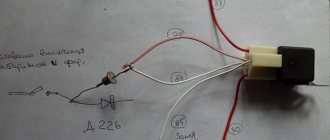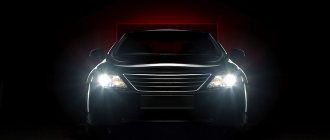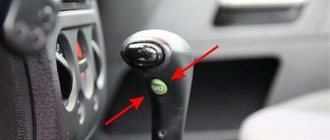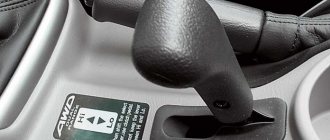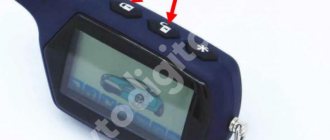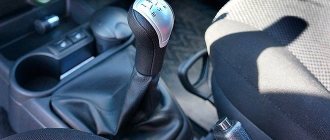Hi all! Modern cars are equipped with different gearboxes, but some components remain the same. For example, this is a neutral gear on an automatic transmission, on a manual transmission and on the same sequential gearbox.
Having not studied the principle of operation, motorists who previously drove a manual gearbox begin to ask all sorts of questions due to the habits formed at the previous checkpoint.
In particular, not everyone understands why neutral is needed on an automatic transmission, whether it is possible to coast in this case, and how to use this gear correctly so as not to harm your own vehicle.
But not everything that can be done with neutral on a manual transmission can be done on an automatic transmission. That's what this material was prepared for. Today we’ll talk about such a unit as an automatic transmission and neutral on it.
Why is there neutral on the automatic?
You probably know why you need a neutral on the box. If not, then I remind you.
If you suddenly forgot which letter is used to designate neutral gear, then I will say that it is N.
When the gearbox lever is moved to the neutral position, the torque from the engine installed on the car is not transmitted to the wheels. Thus the car does not move.
Neutral on manual transmissions is used almost constantly and everywhere. And precisely at traffic lights, when idle in traffic jams, etc. In the case of an automatic transmission, the role of neutral is significantly simplified. Much fewer functions and responsibilities are transferred to it compared to mechanics. This is why difficulties arise when switching from a manual transmission to an automatic transmission. Then it turns out that the box is shaking and breaks down, because the driver simply mismanaged the neutral gear, transferring habits from the mechanics.
There are a number of drivers who, during the entire period of operating an automatic transmission, have never even engaged neutral.
However, this mode is still extremely necessary on any car equipped with an automatic transmission.
Neutral on an automatic transmission plays a key role when towing a car.
If you look at the instruction manual, you can find useful and important information there. Automakers recommend turning on the N position on the box when towing.
In fact, the automatic transmission drives in neutral when towing, but at a speed not exceeding 50 kilometers per hour.
There is also additional information in the recommendations. According to the requirements of automakers, they advise towing a car with neutral on for no more than 50 kilometers. This is the maximum permissible distance. If you have to cover more serious distances, then you should use the services of a tow truck or towing with raised drive wheels. Otherwise, serious malfunctions may occur.
It's hardly worth risking the integrity of the box.
Neutral can also be used in the riser if there are problems with the parking mode. But this is a last resort. Before parking the car, make sure that mode P is selected.
Why do you need a neutral automatic transmission mode?
The most frequently used modes in automatic transmissions are “P” and “D”; the selector is moved from one mode to another, bypassing the “N” position. The operating instructions say that neutral gear is needed to transport (tow) a car, for example, if it is in a faulty condition. But it is not advisable to tow a car with an automatic transmission; in extreme cases, it is permissible to transport a car with an automatic transmission at speeds of up to 35 km/h and over short distances. If for some reason the car cannot move independently, the best solution is to call a tow truck.
Nothing bad will happen to the transmission if, when the car is parked, the gearbox selector is in the “N” position instead of “P”, but then you need to apply the handbrake, otherwise the car, standing on a slope, may roll away. And if you put the car in neutral while parking, it will be inconvenient to start the engine - you will have to hold the brake pedal. In parking mode "P", the drive wheels are locked and the car will not go anywhere.
Neutral in traffic jams and traffic lights
If you are a former owner of a car with a manual transmission, then switching to a CVT or automatic transmission may cause some problems in the initial stages of operating an automatic transmission.
A very common habit is to act at traffic lights and in traffic jams.
All manual drivers know that when approaching a traffic light or getting into a traffic jam, it is necessary to move the gearbox handle to the neutral position. And start from there when the green light turns on or the traffic jam moves. This is what motorists do to be able to remove their foot from the clutch. But the automatic machine simply does not have this pedal. Therefore, there is also no need to switch to a neutral position. Everything is extremely simple. But we need to study the issue in more detail.
It is necessary to understand why this mode cannot be enabled. When the driving mode is activated (Drive, Drive or D), the torque converter builds up pressure in the box, which facilitates the transmission of torque.
In this mode, all internal elements are actively lubricated. If the gas pedal is not depressed, the transformer is in the so-called green zone. Then there is only lubrication, and nothing more.
If you switch to neutral, both shafts (output and input) will open. This will stop the lubrication process.
Lada XRAY 2.5 thousand km - review from a real owner. Part 5
So I got to the most controversial part of my review/review - the AvtoVAZ automatic transmission. What to take: an AMT robot or simple mechanics - this is the most common question on forums and communities visited by Lada XRAY.
Robot AMT
I will describe my feelings and my conclusions. If you do not agree with them, welcome to the comments.
You need to understand that the AMT robotic gearbox has both its advantages from mechanics and its disadvantages, again, from mechanics.
Due to the fact that the robot depresses the clutch and changes speed, the driver cannot interfere with this process at all. The box has no eyes and does not understand what you want from it at this very moment. You can only tell how the gas works and that’s it.
If a hydraulic automatic machine’s algorithms have been more or less debugged for a long time, and the technology itself is different, many mechanical problems are simply absent from it. So the comparison can be purely speculative. But in fact, AMT is not an automatic machine, and that says it all!
Pros of AMT
- The main advantage of the robot is that engine power is not lost due to the torque converter of a conventional automatic transmission.
- The car can be towed with a cable.
- The car can be started "from the pusher".
- You can jump out of the mud “into the swing.”
Cons of AMT
- When switching, the connection between the engine and the wheels is broken and theoretically this can provoke a skid in icy conditions (this can be solved by switching to manual mode).
- Until you press the gas, the car stops (features of the robot), in contrast to the easy acceleration with an automatic transmission.
Because of this, it is more difficult to take off on an uphill climb - the car rolls back, and it is not so convenient in a traffic jam. - The gear shift speed cannot be adjusted. It takes 2 seconds and that’s it!
- It is impossible to control the coasting and because of this the car jerks in 1st and 2nd gears.
Everything seems simple, but the devil is in the details!
Rollback
Rolling the car back is a huge problem for me, because for 7 years I simply forgot about such a problem.
Although my configuration has a hill starting assistant, it only works when the brake is pressed firmly and when the slope is higher than 2%. That is, on a slight slope the car still tends to roll away. But how much is the question.
And it's unnerving. So if I feel that the car behind me is too close, then I pull away with the handbrake, as I was taught in driving school.
Due to the fact that the car is standing still without pressing the gas pedal, it is more difficult to move in a traffic jam.
In addition, with conventional mechanics, the starting speed is regulated by 2 pedals, and with a little skill, you can even hold the car in place while standing at an uphill intersection, playing with these two pedals (although this is not recommended because you will burn the clutch). And the robot works rough for my taste.
Although perhaps this is also because, out of habit, as with an automatic transmission, I try to give the gas very carefully and weakly. But it turns out: I gave the gas - it doesn’t go, I gave it more - it stops, I gave it more - it jumped forward, and you hit the brake. In general, I try to feel the car, it turns out better every time.
There is no coasting on the robot
Due to the inability to independently control the roll-up in neutral, the robot often jerks, which I really don’t like. I rarely braked with the engine, I coasted more. Here's an example: I'm driving on a secondary road in the city and accelerate from the intersection to the 1-2-3 intersection and turn off the speed and coast.
And then 1-2-3 and the third remains, and when you release the gas the car jerks - the coasting does not turn on. It seems that all the instructions advise to always drive with the speed on, as it also reduces gas mileage.
But if you don’t turn off the speed at 1-2 speeds on any manual transmission, if you release the gas pedal, then there will be jerks and a kind of engine braking.
When moving down a hill, the robot often suddenly decides that it needs to brake with the engine and begins to feverishly apply a lower gear. And in 5 seconds it suddenly turns out that from speed 5 you already have speed 3 or even speed 2, the car slows down too much. It’s difficult to deal with this; you need to either press on the gas (during descent) or switch to manual mode.
Dips when switching
Due to the fact that the robot presses the clutch and also turns on the speed, AvtoVAZ adjusted the switching time to 2 seconds for comfortable driving. And this cannot be changed.
When you drive an automatic transmission, the gear changes almost instantly, you only feel a slight jerk if you press the gas hard. The robot may not have a jerk, but switching takes 2-3 seconds.
The driver feels this time is wasted: he presses the gas, but the car does not accelerate. The passenger doesn't notice anything!
There is a decent gap between speed 1 and 2. There is also a dip between speeds 2 and 3, but it is much less noticeable. At first, the failure really annoyed me. Especially when you turn left or right from a secondary road onto the main road. The robot starts switching right in the middle of the intersection, which is potentially dangerous.
However, the robot has two kickdown modes: when you press halfway and when you press fully. Alas, you can only feel the revolutions with your ear; on an electronic pedal it is almost impossible to determine the difference.
So, with an active kickdown, the robot will not switch until you release the gas . But if you overextend it or overdrive it, it seems to freeze at 4-5 thousand and until the revolutions drop to 1200 - 1500, it will not switch to speed 2. It can be treated by moving the gearbox to neutral and back. Or to manual mode and back.
Again, once you get used to it, this failure doesn’t bother you at all!
Another point is that you can change speeds by playing with the gas pedal. Or, more precisely, tell the robot that it can switch to a higher or lower gear. Information about this is found in fragments in the video, but for some reason it is not systematized! And it’s not in the user manual at all.
In general, at engine speeds somewhere around 2500, when the gas is released, an upshift occurs and the speeds level off. You just need to remember the sound of the engine and feel the moment of switching and there will be no problems.
And if you sharply press about halfway, the box will drop one speed down. If you press it completely, it will reset 2 speeds down. It is important to feel the difference between the first and second kickdown.
Having felt these simple rules, you can move quite confidently in traffic both in the city and on the highway.
A robot for a quiet ride
There is a myth that AvtoVAZ cultivates that the robot is configured for a comfortable ride. This is not entirely true.
If you drive like a vegetable, then the ride is not very comfortable - the robot's thoughtfulness is annoying.
But if you drive actively: you press the gas and turn the engine, then you can drive even with greater comfort.
Paradox? No, these are the box settings.
It turns out that when you drive at a speed of, say, 40 km/h, the robot switches to gear 3, which is logical. And here in the city there is an obstacle ahead, but far away. Therefore, you release the gas and the car smoothly brakes with the engine (everything is also logical).
But the speed remains 3! And then a window appears, you need to speed up (but not much): you step on the gas and POP! First, the engine must leave the 600 rpm mode to at least 1500-2000 thousand, and this is 1-2 seconds, then the pickup begins and the car begins to accelerate.
Another 2-3 seconds. And the window closes.
This moment is quite annoying. If you drive actively, then such braking does not occur in the city and you can quite feel the flow well. But there's a bit of a jam.
How the robot behaves on the highway
But on the highway, surprisingly, the robot performs well - all the time 2000-2500 thousand revolutions, the engine pulls from low, so it’s quite possible to drive actively.
When overtaking, there is an easy kickdown to speed 4 and there is enough time to overtake even a truck at a speed of about 100 km/h. If you need to overtake more or more actively, you can switch to manual mode.
Driver adaptation
I don't know, somehow I didn't notice it. At all. Either I drive too differently, but the automatic machine often doesn’t understand me.
Manual AMT mode
If you wish, you can pull the handle yourself - just pull the joystick to the left in position D.
Speeds are switched by nodding forward - reset, back - add. Quite logical and comfortable.
If you slow down, the robot will try to maintain the speed, but if there is a heavy load on the engine and below the hardwired speed values, then it automatically resets everything down to speed 1. But it doesn’t shift the speed up (maybe it’s possible, but I didn’t turn the engine before the cutoff—it was still during the run-in).
So you can comfortably drive in manual mode in the city, you don’t need to pull the knob at every speed: you go to 4, brake at a traffic light, and the speed resets itself to 1. So all that remains is to touch the knob again to increase. Or when overtaking, reduce the speed down by 1.
When you pull the handle, the speeds subjectively switch a little faster and you drive comfortably - you know that there will be a failure now and you automatically release the gas pedal.
In general, it's convenient. You just need to practice a little.
There is also an up-down shift prompt, but it is not adequate in 90% of cases: you are driving 40 km/h, let off the gas a little, and it advises you to turn on gear 5. Well, and the like. Annoys me, may be useful to someone. It's a pity that you can't turn it off normally.
Will the robot squeeze the clutch?
To be honest, I’ve seen this opinion in videos. But I didn't understand where it came from. There was and still is no smell of a burning clutch (it’s already passed 2,700 thousand).
But in cold damp weather, about 0 in cold weather gives a vibration similar to the clutch disc slipping along the basket. Especially uphill.
This may be due to the fact that the clutch has been worn in and the gap has increased slightly. So I’ll ask for adjustment to TO-0, maybe they’ll also change the firmware.
My opinion about the robot
I described in great detail the behavior of the robot in different situations and what to pay attention to. But I don’t have a clear answer to the question: which is better: a robot or a mechanic!
Very strange sensations: on the one hand, this gearbox has better consumer qualities than a manual transmission, is more convenient to use, and more progressive. On the other hand, compared to an automatic transmission, it loses outright! And let me remind you again, I drove an automatic for 7 years and got used to it.
And I don’t understand how you can do a thing that you need to learn to manage separately. No, there are generally accepted skills in driving a car, and why should I also learn to control a robot box, and even without information or tips. And in 3 months I can’t get used to the car! I would drive a manual for 2-3 weeks and drive calmly, I have 13 years of experience in mechanics.
So only you can answer this question: order a test drive at a car dealership and drive the car in different modes. I really don’t recommend buying without a test drive!
The fact that it sits on this box with mechanics will be easier. But all the same, no matter what kind of automatic transmission they take (another brand, not XRAY) or AMT, they will still spit a lot and often at the automatic and think that “a manual would be OH-H-H-H.” Until they get used to it. And they won’t reconcile themselves. Believe me, for the first 2-3 years you will still be looking for the gear shift lever :).
But I definitely don’t recommend this gearbox to people with automatic transmission experience! Having driven the best, you will be very unpleasantly surprised and upset at the worst. You will have to come to terms with a lot of unpleasant nuances of this box.
Personally, I would rather pay this unfortunate 25 thousand extra for a full-fledged automatic transmission or save on the configuration (I still took it on credit).
Previous parts of the review
Source: https://garage-yourself.ru/lada-xray-2500-tyisyach-km-otzyiv-realnogo-vladeltsa-chast-5/
The cheapest foreign cars to maintain: reliable and inexpensive
When you see a green light turn on in front of you, or realize that the traffic in a traffic jam is about to start moving, by switching to neutral first and then switching to drive again, you will create conditions of serious stress for your transmission. This is due to the fact that the pressure inside the system will change dramatically. Therefore, the automatic transmission components will have to perform additional manipulations and movements, which will ultimately affect the life of the entire gearbox.
The same should be considered when you are in a traffic jam. In traffic jams there is no need to switch from drive to neutral.
A little about the design of the automatic transmission
We have already written about the design of automatic transmissions in the materials “What happens if. when moving forward, engage reverse gear”, “What happens if. press the gas and brake at the same time,” in which they discussed the processes occurring while the car is moving. Now let's take a closer look at the operation of the automatic transmission in neutral mode.
Let us recall that in an automatic transmission, power from the engine is transmitted through a torque converter (which acts as a clutch) to the automatic transmission input shaft.
A range selection valve is connected to the automatic transmission selector lever, which, depending on the position of the lever, prohibits the inclusion of certain gears.
Automatic transmission section (Mercedes):
Automatic transmission device
Most owners of vehicles with automatic transmission have probably come across publications about what will happen if, while driving in a straight line, the automatic transmission lever is moved to the “reverse” position or the accelerator and brake are pressed at the same time. Therefore, we will not dwell on them, but consider the processes occurring in an automatic transmission when driving in neutral gear.
It is known that the force from the power unit is transmitted to the input shaft of the “automatic machine” through a special torque converter. In the system it performs the clutch function.
To form gears in the automatic transmission, special planetary gears are provided, which are represented by satellite gears rotating relative to the central shaft. Gear shifting is carried out by fixing the elements of the box, for which hydraulics and an electronic control unit are responsible. The system works like this: the ECU analyzes the performance indicators of the power unit and the output shaft, after which the appropriate gear is selected and engaged.
The automatic transmission selector has a range filtering unit, the function of which is to prevent automatic gear shifting when the gearbox lever is in a certain position.
Transmission oil performs a lubricating function and effectively removes heat, preventing overheating of the gearbox elements. Its pressure, necessary for the full operation cycle of the automatic transmission, is created using an oil pump.
What is the N position used for?
One of the most common questions among those who have recently switched to an automatic transmission is why a neutral is needed on an automatic transmission and in what situations it is used.
Neutral on an automatic transmission is significantly different in its application from the use of neutral on a manual transmission.
Very often, drivers who have previously driven manuals all their lives, out of habit, turn on neutral at traffic lights, and then switch to Drive again. This is a common mistake that can lead to serious negative consequences.
Considering the difference between automatic transmission and manual transmission, you need to understand in more detail why you need and when you do not need neutral speed on an automatic transmission. The following situations will be considered separately:
Before we discuss this and understand what the neutral position on the machine is for, it is important to consider one thing.
By moving to position N, the clutches in the torque converter disengage, and the interaction between the internal combustion engine and the wheels is broken. The torque converter continues to rotate, but does not connect the chassis elements to the engine.
Neutral is mainly used in situations where you need to unlock the wheels. Most often, N mode is selected when it is necessary to tow the car, or when servicing the car at a service station.
Coasting
Let's start with whether it is possible with an automatic transmission, as in the case of a manual transmission, to drive in neutral down hills and long descents. Motorists who prefer manual transmissions are accustomed to saving fuel in this way. After all, when coasting, gasoline is not consumed.
But here it is important to understand what will happen to the automatic transmission if you move the selector to the neutral position.
At this moment, the oil supply to the internal components of the box will stop, the internal pressure will change, and the elements will rotate dry.
Since an automatic transmission has a number of rubbing elements that constantly need lubrication in the form of gear oil, operation without lubricant leads to accelerated wear of parts. Surfaces rub against each other, heat up, wear out and fail.
As you understand, because of this, it is categorically not recommended to roll down a hill in neutral if we are talking about an automatic transmission.
Likewise, you should not suddenly turn on the Drive position when descending. This will literally lead to the destruction of the clutches. After all, when switching to Drive, there is a strong push from the oil pump. This phenomenon is actually detrimental to the torque converter unit.
If you move downhill automatically, then only with the lever in Drive mode. You just need to release the gas pedal so as not to waste extra fuel. In this position, the box will not be damaged, since it will continue to be supplied with the right amount of oil.
Regarding coasting on an automatic transmission with neutral engaged, the following conclusions can be drawn:
Such actions lead to only one thing. This is an automatic transmission failure.
Traffic lights and traffic jams
There is the most important and most common misconception regarding whether it is possible to put the automatic transmission in neutral while in a long traffic jam or stopping at a traffic light.
In the case of mechanics, everything is extremely clear. When approaching a red light, or when stopped due to traffic, you can safely put it in neutral and then shift into gear to continue driving. Neutral is turned on to allow you to temporarily remove your foot from the clutch and give it a rest. Plus it’s better to start from first gear.
But you need to figure out what will happen if you put neutral gear in such a situation on the automatic transmission.
To understand this, you need to understand the essence of how an automatic transmission works. By turning the selector to the Drive position, the torque converter constantly builds up pressure, which helps transmit torque. In this position, all internal elements are actively lubricated with transmission oil. If you do not hold the gas pedal down, the torque converter simply goes into the so-called green operating mode. This means that only one process is taking place. And this is lubricating the elements with oil.
If you select neutral, then the input and output shafts will open and the lubrication process will be interrupted. The pump will not supply oil to internal components. When the traffic light turns green, or when driving in a traffic jam, the driver naturally switches to the Drive position. Such a switch creates extreme stress for the box, since the pressure instantly changes.
The internal components of the gearbox have to perform additional actions and movements, which negatively affects their condition and accelerates wear.
By analogy, the issue of prolonged downtime in a traffic jam is considered. You shouldn’t keep switching from position D to mode N and back several times in 5 minutes.
If you have to stand in a traffic jam for a long time without moving, it is better to switch to parking mode or completely turn off the engine.
Actions according to this scheme will protect the automatic transmission from premature wear and breakdown. You cannot stand in neutral in traffic jams or at traffic lights. In theory, this can be done. But there is no need for this. You will only provoke unnecessary problems with the machine.
Parking
Separately, we need to talk about the possibility and necessity of moving the automatic transmission to the neutral position when the car is parked or parked.
Owners of manual cars often abuse the fact that they start squeezing the gas to the floor while stationary. Hence the logical question regarding whether it is possible to accelerate if you are in neutral on the automatic transmission.
In fact, opinions differ on this matter. Some believe that this is strictly prohibited. Others are confident that nothing bad will happen. And the truth is in the middle. You can gas, but only with wisdom and caution. Old automatic transmissions are more susceptible to such actions and do not like excessively high speeds in neutral. Many modern cars have a cutoff on the tachometer, above which the engine cannot be turned in neutral.
But this is the advice. It’s not worth accelerating on the spot unless necessary.
As for being in the parking lot, before you turn off the engine on the automatic and leave the car in neutral, make sure whether this is possible.
For parking and parking, the automatic transmission has a special gearbox mode P or Parking. This is what needs to be used.
But it happens that this mode does not work, there are some problems. This is rare, but it cannot be ruled out. In this situation, a neutral comes to the rescue. The box can be placed in this position by simultaneously applying the parking brake. But as soon as necessary, be sure to resume P mode and try to use only it.
As for starting after parking on N, then you will need to turn off the parking brake and depress the brake pedal before starting the engine. That's it, you can hit the road.
Towing
And one more equally important question. It concerns whether it is possible to tow a car with an automatic transmission while driving in neutral.
It is not advisable to tow a car with an automatic transmission that cannot drive itself. This is stated in all manuals. It's best to call a tow truck.
But the manual says that towing is allowed if necessary. There are some restrictions:
Some even limit the distance to 10-20 km. If the service station or garage is further away, it is better to call a tow truck. If partial loading is performed, then the drive wheels need to be loaded onto the tow truck.
You can tow other cars and trailers automatically. To do this, it is only recommended to switch to Overdrive mode and adhere to the general rules of towing, compliance with weight restrictions, speed and distance.
